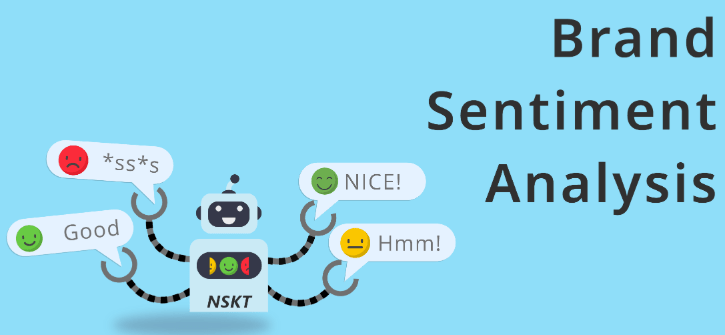Brand sentiment analysis has emerged as a pivotal tool in the era of digital communication. In simple terms, it involves the process of gauging and interpreting the emotions and opinions expressed towards a brand. As the digital landscape continues to evolve, understanding brand sentiment has become crucial for businesses striving to maintain a positive image in the eyes of consumers.
Why Brand Sentiment Analysis Matters

In a world where online reputation can make or break a brand, sentiment analysis plays a critical role. The sentiments expressed by consumers directly impact how a brand is perceived. Positive sentiments can foster brand loyalty, while negative sentiments can lead to a decline in consumer trust. Understanding and managing these sentiments is paramount for businesses looking to thrive in competitive markets.
Tools and Technologies
The technological landscape has witnessed remarkable advancements in tools dedicated to sentiment analysis. Artificial Intelligence (AI) and machine learning algorithms are now at the forefront, providing businesses with sophisticated tools to analyze and interpret vast amounts of data. These technologies not only automate the process but also enhance the accuracy of sentiment analysis.
Steps in Brand Sentiment Analysis
The journey of brand sentiment begins with the collection and preprocessing of data. Gathering data from various sources, including social media, customer reviews, and surveys, forms the foundation. Subsequently, sentiment classification techniques, often powered by machine learning, are employed to categorize the sentiments expressed as positive, negative, or neutral.
Benefits for Businesses
Implementing brand sentiment analysis brings several advantages to businesses. By understanding the sentiments of their audience, companies can tailor their products and services to meet consumer expectations, thereby enhancing the overall customer experience. Moreover, proactive management of brand sentiment contributes to building a positive brand reputation.
Challenges in Brand Sentiment Analysis
However, the road to effective sentiment analysis is not without its challenges. Sarcasm, nuanced expressions, and the sheer volume of data present obstacles that demand careful consideration. Striking a balance between automated tools and human oversight becomes essential to overcome these challenges.
Real-World Applications
Several businesses have successfully harnessed the power of brand sentiment analysis in their marketing strategies. Case studies reveal how brands have pivoted based on sentiment insights gathered from social media platforms. The impact on marketing strategies, including targeted advertising and content creation, is evident.
Future Trends
Looking ahead, the field of sentiment analysis is poised for continuous evolution. As technologies advance, sentiment analysis is expected to integrate seamlessly with other marketing strategies. The future holds promises of more accurate and insightful sentiment interpretations, opening new avenues for businesses to connect with their audience.
Ethical Considerations
While sentiment analysis offers immense potential, ethical considerations cannot be overlooked. Privacy concerns regarding the collection and use of consumer data must be addressed responsibly. Striking a balance between gaining insights and respecting consumer privacy is crucial for the ethical implementation of brand sentiment analysis.
Measuring Success
Key performance indicators (KPIs) play a vital role in determining the success of brand sentiment analysis efforts. Metrics such as sentiment score, engagement levels, and brand mentions provide valuable insights. Continuous monitoring and adjustments based on these KPIs contribute to the ongoing improvement of sentiment analysis strategies.
Expert Opinions
Industry experts weigh in on the significance of brand sentiment analysis. Their insights provide a deeper understanding of the nuances involved and offer practical tips for successful implementation. Combining expert knowledge with practical application enhances the effectiveness of sentiment analysis strategies.
DIY Brand Sentiment Analysis
For small businesses with budget constraints, conducting sentiment analysis is still within reach. There are free or affordable tools available, coupled with practical tips for a DIY approach. Even on a smaller scale, the insights gained from sentiment analysis can guide business decisions and foster positive brand perception.
The Human Touch in Sentiment Analysis
Despite the technological advancements, the human touch remains indispensable. Human reviewers play a crucial role in refining sentiment analysis results, especially when dealing with context-heavy expressions. Striking a balance between automation and human insights ensures a more nuanced and accurate sentiment analysis.
Case Study: Leveraging Brand Sentiment Analysis for Marketing Success
In this digital landscape, the company is depending on digital platforms and social media to reach its customers. This makes the social media insights valuable, with the data it provides about the customers. A company realized the importance of social media insights and decided to analyze them. Through tracking the customer’s sentiment about the products, services, and the whole brand. To know how they see the company. Leading to improve this image and keeping the sentiment positive for the brand. To keep the company’s reputation in a better place in the market.
The Challenge: Rebuilding Trust Amid Customer Backlash
A well-established company in the consumer electronics, was facing challenges in understanding the customer’s sentiment. They notice that they have a decline in customer satisfaction and brand recall. They found that the reason was due to having many negative customer feedback about the brand and products. As this negativity was affecting the brand reputation, they realized that they needed a better understanding of the customer sentiment and to analyze it. To be able to improve their services to enhance the sentiment.
How They Used Brand Sentiment Analysis
To address all these challenges, they decided to depend on an advanced sentiment analysis tool that is powered by AI and machine learning. They gather the insights from all the available sources, including reviews, feedback, and social media comments. Through this sentiment analysis, the company was able to know how their customers are reacting to the brand in real time.
- Product Dissatisfaction: A huge number of the negative sentiment was related to the product dissatisfaction. As the customers were expecting better products, they were open to getting solutions.
- Service Complaints: There were many complaints about the customer service. As many customers felt that they were treated unwell when asking for support from customer services.
Actions Taken Based on Insights
With this insight about the customer sentiment, the company started to take action.
- Improved Communication: They launched a campaign to communicate with the customers about their issues. Through gathering their complaints and problems they faced. Then, offering a solution to them to enhance their satisfaction.
- Enhanced Customer Service Training: Recognizing the complaints about the customer service, the company started a training program. To make the customer support team more effective and offer real solutions. This improved the communication, leading to an improvement in customer satisfaction across the different channels.
- Product Improvements: Based on the customer feedback about the products, they were able to identify the areas of improvement. To be able to improve their products and achieve the customer’s expectations for products.
The Results: Positive Turnaround
After applying these changes, the company noticed a change in its image. As the social media reviews become more positive, customers appreciate the changes that have happened in the products. Leading to a decrease in the negative sentiment and an increase in the positive sentiment. This ended up with an increase in the overall sales, especially for the products that were adjusted based on customer feedback.
Conclusion
In conclusion, brand sentiment analysis stands as a cornerstone for businesses aiming to thrive in the digital age. The ability to understand, interpret, and respond to consumer sentiments is a powerful tool that directly influences brand success. As technology continues to evolve, embracing sentiment analysis becomes not just a strategy but a necessity for businesses looking to secure their place in the hearts and minds of consumers.
Explore the power of sentiment analysis with AIM Technologies. Request a demo today to discover how our cutting-edge tools can elevate your brand’s understanding of customer sentiments and drive impactful marketing strategies.
FAQs
Is brand sentiment analysis only relevant for big businesses?
- No, sentiment analysis is beneficial for businesses of all sizes. It helps small businesses understand their customers and improve their offerings.
How often should businesses conduct brand sentiment analysis?
- The frequency depends on the industry and the level of online engagement. Regular monitoring is recommended, with more frequent analysis during significant events or product launches.
Are there any ethical concerns with collecting consumer data for sentiment analysis?
- Yes, there are ethical considerations. Businesses must be transparent about data collection and prioritize consumer privacy.
Can sentiment analysis tools accurately interpret sarcasm and nuanced expressions?
- While advancements have been made, challenges persist. Human reviewers often play a crucial role in interpreting context-heavy expressions accurately.
What are the key indicators of success in brand sentiment analysis?
- Key performance indicators (KPIs) include sentiment scores, engagement levels, and the frequency of positive and negative brand mentions.




